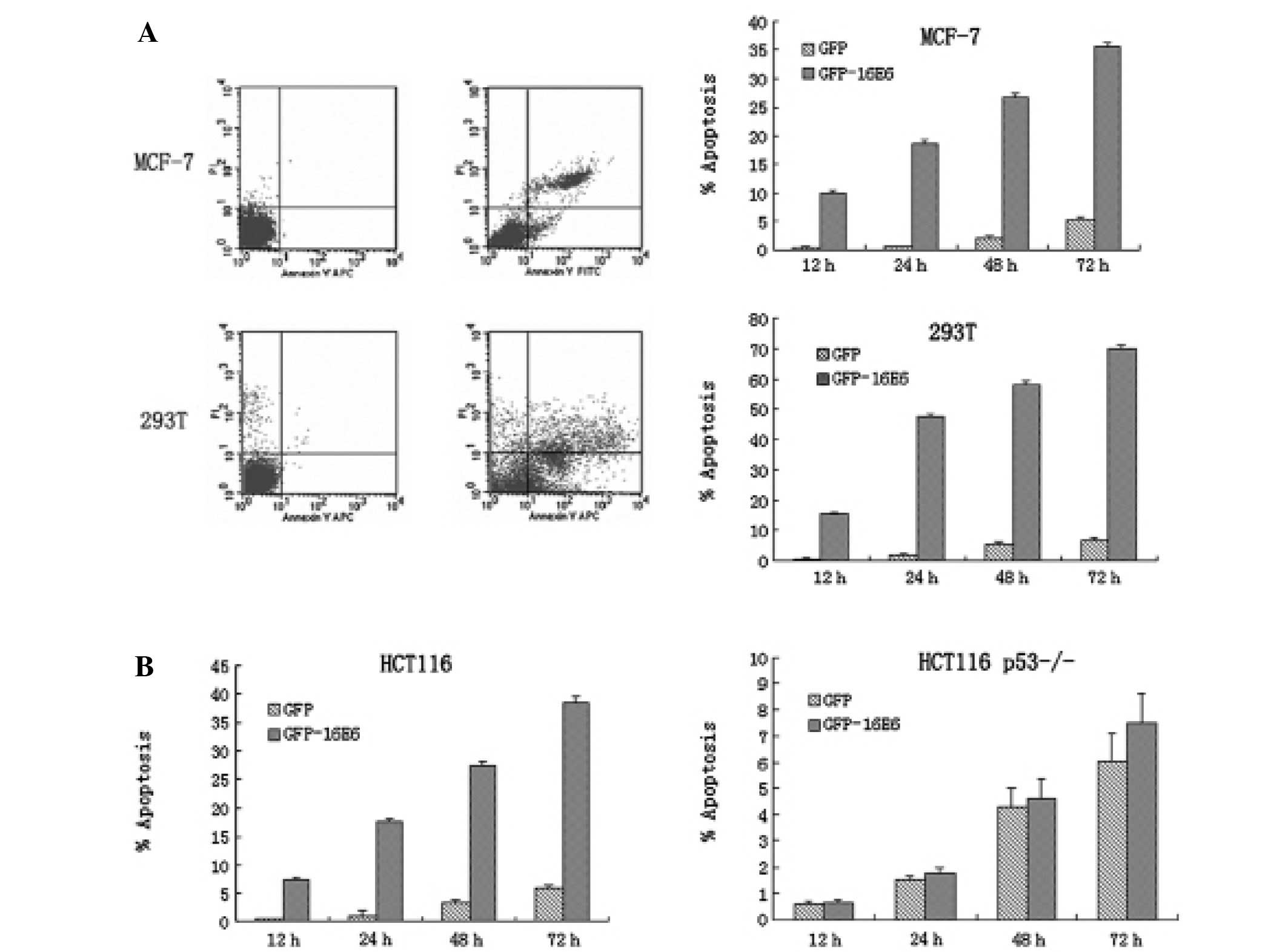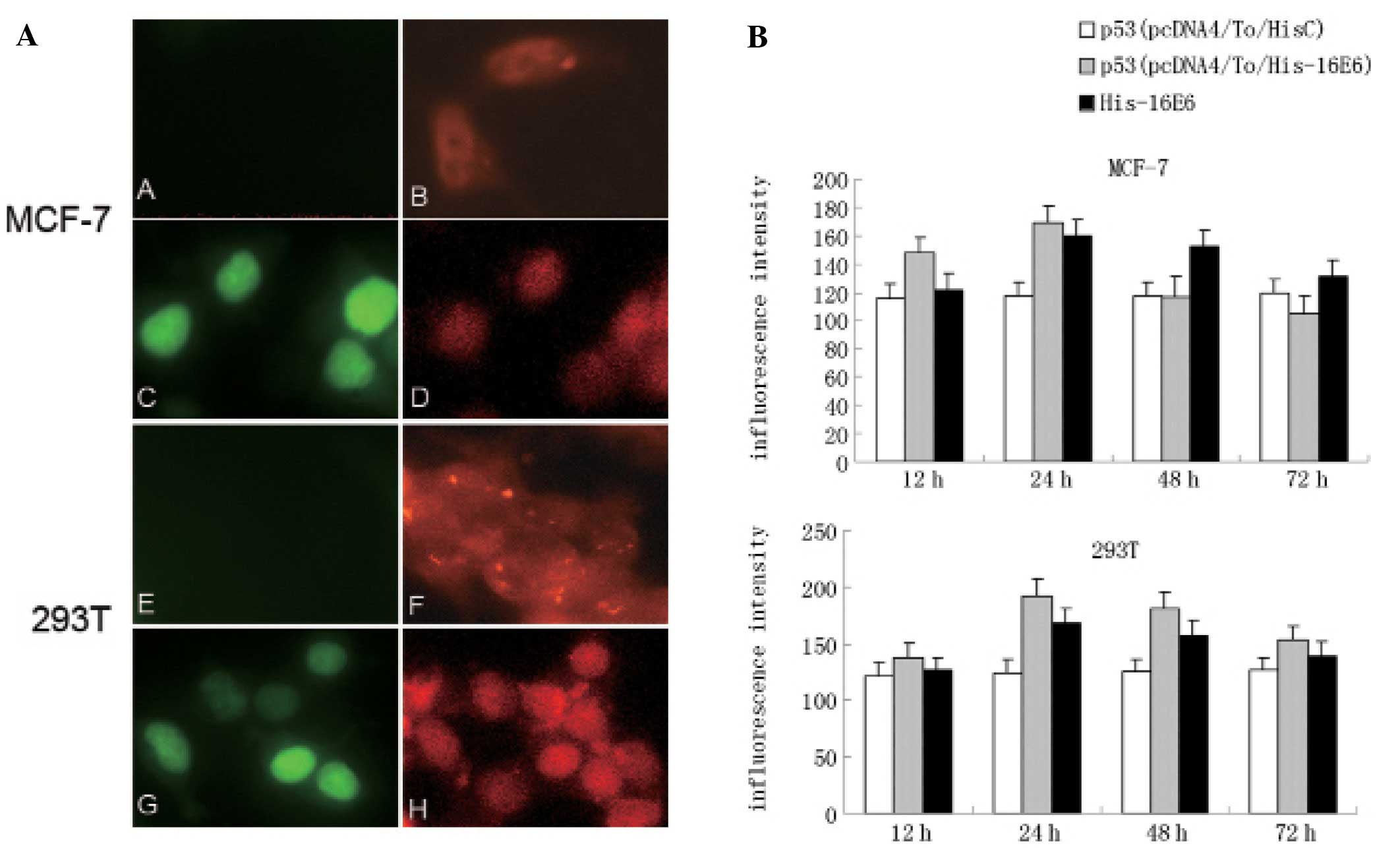|
1
|
Antonsson A, Spurr TP, Chen AC, et al:
High prevalence of human papillomaviruses in fresh frozen breast
cancer samples. J Med Virol. 83:2157–2163. 2011. View Article : Google Scholar : PubMed/NCBI
|
|
2
|
Jones DL, Thompson DA and Munger K:
Destabilization of the RB tumor suppressor protein and
stabilization of p53 contribute to HPV type 16 E7-induced
apoptosis. Virology. 239:97–107. 1997. View Article : Google Scholar : PubMed/NCBI
|
|
3
|
Honda R and Yasuda H: Activity of MDM2, a
ubiquitin Ligase, toward p53 or itself is dependent on the RING
finger domain of the ligase. Oncogene. 19:1473–1476. 2000.
View Article : Google Scholar : PubMed/NCBI
|
|
4
|
DiMaio D: The role of human
papillomaviruses in cancer. J Neurovirol. 14:50. 2005.
|
|
5
|
Liu YM, McKalip A and Herman B: Human
papillomavirus type 16 E6 and HPV-16 E6/E7 sensitize human
keratinocytes to apoptosis induced by chemotherapeutic agents:
Roles of p53 and caspase activation. J Cell Biochem. 78:334–349.
2000. View Article : Google Scholar : PubMed/NCBI
|
|
6
|
Meek DW: The p53 response to DNA damage.
DNA Repair. 3:1049–1056. 2004. View Article : Google Scholar : PubMed/NCBI
|
|
7
|
Chang YC, Liao CB, Hsieh PY, Liou ML and
Liu YC: Expression of tumor suppressor p53 facilitates DNA repair
but not UV-induced G2/M arrest or apoptosis in Chinese hamster
ovary CHO-K1 cells. J Cell Biochem. 103:528–537. 2008. View Article : Google Scholar : PubMed/NCBI
|
|
8
|
Wei J, O’Brien D, Vilgelm A, et al:
Interaction of Helicobacter pylori with gastric epithelial
cells is mediated by the p53 protein family. Gastroenterology.
134:1412–1423. 2008.
|
|
9
|
Mayer C and Grummt I: Cellular stress and
nucleolar function. Cell Cycle. 4:1036–1038. 2005. View Article : Google Scholar : PubMed/NCBI
|
|
10
|
Qian H, Wang T, Naumovski L, Lopez CD and
Brachmann RK: Groups of p53 target genes involved in specific p53
downstream effects cluster into different classes of DNA binding
sites. Oncogene. 21:7901–7911. 2002. View Article : Google Scholar : PubMed/NCBI
|
|
11
|
Sherman L and Schlegel R: Serum- and
calcium-induced differentiation of human keratinocytes is inhibited
by the E6 oncoprotein of human papillomavirus type 16. J Virol.
70:3269–3279. 1996.PubMed/NCBI
|
|
12
|
Liang XH, Volkmann M, Klein R, Herman B
and Lockett SJ: Co-localization of the tumor-suppressor protein p53
and human papillomavirus E6 protein in human cervical carcinoma
cell lines. Oncogene. 8:2645–2652. 1993.PubMed/NCBI
|
|
13
|
Kelley ML, Keiger KE, Lee CJ and
Huibregtse JM: The global transcriptional effects of the human
papillomavirus E6 protein in cervical carcinoma cell lines are
mediated by the E6AP ubiquitin ligase. J Virol. 79:3737–3747. 2005.
View Article : Google Scholar : PubMed/NCBI
|
|
14
|
Tao M, Kruhlak M, Xia S, Androphy E and
Zheng ZM: Signals that dictate nuclear localization of human
papillomavirus type 16 oncoprotein E6 in living cells. J Virol.
77:13232–13247. 2003. View Article : Google Scholar : PubMed/NCBI
|
|
15
|
Li X and Coffino P: High-risk human
papillomavirus E6 protein has two distinct binding sites within
p53, of which only one determines degradation. J Virol.
70:4509–4516. 1996.PubMed/NCBI
|
|
16
|
Momand J and Zambetti GP: Mdm-2: ‘big
brother’ of p53. J Cell Biochem. 64:343–352. 1997.
|
|
17
|
Butz K, Shahabeddin L, Geisen C,
Spitkovsky D, Ullmann A and Hoppe-Seyler F: Functional p53 protein
in human papillomavirus-positive cancer cells. Oncogene.
10:927–936. 1995.PubMed/NCBI
|
|
18
|
Chalfie M, Tu Y, Euskirchen G, Ward WW and
Prasher DC: Green fluorescent protein as a marker for gene
expression. Science. 263:802–805. 1994. View Article : Google Scholar : PubMed/NCBI
|
|
19
|
Zheng Y, Zhang J and Rao Z: Ribozyme
targeting HPV16 E6E7 transcripts in cervical cancer cells
suppresses cell growth and sensitizes cells to chemotherapy and
radiotherapy. Cancer Biol Ther. 3:1129–1135. 2004. View Article : Google Scholar : PubMed/NCBI
|
|
20
|
Gross-Mesilaty S, Reinstein E, Bercovich
B, et al: Basal and human papillomavirus E6 oncoprotein-induced
degradation of Myc proteins by the ubiquitin pathway. Proc Natl
Acad Sci USA. 95:8058–8063. 1998. View Article : Google Scholar : PubMed/NCBI
|
|
21
|
Ronco LV, Karpova AY, Vidal M and Howley
PM: Human papillomavirus 16 E6 oncoprotein binds to interferon
regulatory factor-3 and inhibits its transcriptional activity.
Genes Dev. 12:2061–2072. 1998. View Article : Google Scholar : PubMed/NCBI
|
|
22
|
Kumar A, Zhao Y, Meng G, et al: Human
papillomavirus oncoprotein E6 inactivates the transcriptional
coactivator human ADA3. Mol Cell Biol. 22:5801–5812. 2002.
View Article : Google Scholar : PubMed/NCBI
|
|
23
|
Ferrigno P and Silver PA: Regulated
nuclear localization of stress-responsive factors: how the nuclear
trafficking of protein kinases and transcription factors
contributes to cell survival. Oncogene. 18:6129–6134. 1999.
View Article : Google Scholar : PubMed/NCBI
|
|
24
|
Hollstein M, Rice K, Greenblatt MS, et al:
Database of p53 gene somatic mutations in human tumors and cell
lines. Nucleic Acids Res. 22:3551–3555. 1994.PubMed/NCBI
|
|
25
|
Diaz D, Santander MA and Chavez JA: HPV-16
E6 and E7 oncogene expression is downregulated as a result of Mdm2
knockdown. Int J Oncol. 41:141–146. 2012.PubMed/NCBI
|
|
26
|
Hwang SJ, Suh MJ, Yoon JH, et al:
Identification of characteristic molecular signature of Mullerian
inhibiting substance in human HPV-related cervical cancer cells.
Int J Oncol. 39:811–820. 2011.PubMed/NCBI
|
|
27
|
Kawamata Y, Mitsuhashi A, Unno Y, et al:
HPV 16-E6-mediated degradation of intrinsic p53 is compensated by
upregulation of p53 gene expression in normal cervical
keratinocytes. Int J Oncol. 21:561–567. 2002.PubMed/NCBI
|
|
28
|
Fouret P, Dabit D, Sibony M, et al:
Expression of p53 protein related to the presence of human
papillomavirus infection in precancer lesions of the larynx. Am J
Pathol. 146:599–604. 1995.PubMed/NCBI
|
|
29
|
Isaacs JS, Chen P, Garza A, Hansen MF,
Barrett JC and Weissman BE: Failure of HPV E6 to rapidly degrade
p53 in human HeLa x PNET cell hybrids. Oncogene. 14:1669–1678.
1997. View Article : Google Scholar : PubMed/NCBI
|
|
30
|
Shin YC, Nakamura H, Liang X, et al:
Inhibition of the ATM/p53 signal transduction pathway by Kaposi’s
sarcoma-associated herpesvirus interferon regulatory factor 1. J
Virol. 80:2257–2266. 2006.PubMed/NCBI
|
|
31
|
Accardi R, Dong W, Smet A, et al: Skin
human papillomavirus type 38 alters p53 functions by accumulation
of deltaNp73. EMBO Rep. 7:334–340. 2006. View Article : Google Scholar : PubMed/NCBI
|
|
32
|
Li L, Guo L, Tao Y, et al: Latent membrane
protein 1 of Epstein-Barr virus regulates p53 phosphorylation
through MAP kinases. Cancer Lett. 255:219–231. 2007. View Article : Google Scholar : PubMed/NCBI
|
|
33
|
Granja AG, Nogal ML, Hurtado C, et al:
Modulation of p53 cellular function and cell death by African swine
fever virus. J Virol. 78:7165–7174. 2004. View Article : Google Scholar : PubMed/NCBI
|





















